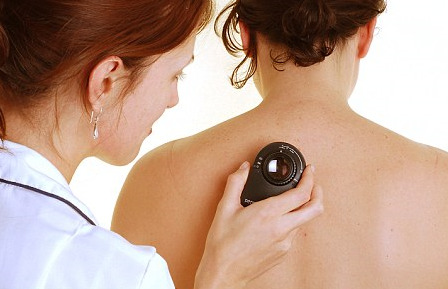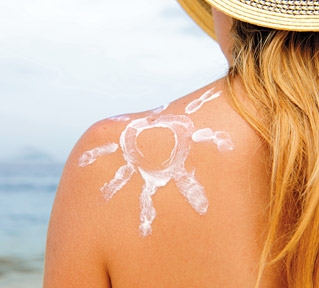
Skin cancer occurs when skin cells are damaged, for example, by overexposure to ultraviolet (UV) radiation from the sun.
skin cancers account for around 80% of all newly diagnosed cancers
between 95 and 99% of skin cancers are caused by exposure to the sun
GPs have over 1 million patient consultations per year for skin cancer
There are three main types of skin cancer:
melanoma – the most dangerous form of skin cancer
basal cell carcinoma*
squamous cell carcinoma*
*Both basal cell carcinoma and squamous cell carcinoma are known as non-melanoma skin cancer.
Self examination
Many melanomas are discovered by people themselves or by a family member.
Cancer Council recommends all adults, particularly those aged 40 and over, should:
Become familiar with their skin
check all areas of their skin, including skin not normally exposed to the sun
look for changes in shape, colour or size, or a new spot – if you notice anything unusual, see your doctor straight away
seek assistance from others to check difficult to see areas, such as their back.
Tips for checking your own skin
It's time to go through a do-it-yourself skin examination: first find a room with good light and a full length mirror. If you are on your own have a hand-held mirror to check difficult to see areas. Undress completely and start examining your skin, body part-by-body part, until you have checked your whole body.
The sooner a skin cancer is identified and treated, the better your chance of avoiding surgery or, in the case of a serious melanoma or other skin cancer, potential disfigurement or even death.
It is also a good idea to talk to your doctor about your level of risk and for advice on early detection.
It's important to get to know your skin and what is normal for you, so that you notice any changes. Skin cancers rarely hurt and are much more frequently seen than felt.
Develop a regular habit of checking your skin for new spots and changes to existing freckles or moles.
How to check your skin
Make sure you check your entire body as skin cancers can sometimes occur in parts of the body not exposed to the sun, for example soles of the feet, between fingers and toes and under nails.
Undress completely and make sure you have good light.
Use a mirror to check hard to see spots, like your back and scalp, or get a family member, partner or friend to check it for you.
These are some changes to look out for when checking your skin for signs of any cancer:
New moles.

An outline of a mole that becomes notched.
A spot that changes colour from brown to black or is varied.
A spot that becomes raised or develops a lump within it.
The surface of a mole becoming rough, scaly or ulcerated.
Moles that itch or tingle.
Moles that bleed or weep.
Spots that look different from the others.
Mole or skin cancer?
Almost all of us have moles. Moles are not normally present at birth, but appear in childhood and early teenage years. By the age of 15, Australian children have an average of more than 50 moles.
Normal moles usually look alike. See your doctor if a mole looks different or if a new mole appears after the age of 25. The more moles a person has, the higher the risk of melanoma.
Harmless coloured spots that range from 1mm to 10mm.
Uniform in shape and even coloured. May be raised.
The more moles or freckles you have the higher your risk of skin cancer.
May have uneven borders and multiple colours like brown and black.
Observe moles carefully for any sign of change.
Although you may notice one or more skin changes, it does not necessarily mean that you have skin cancer, however it is important that you visit your GP to have them investigated further. Your GP can discuss your skin cancer risk and advise you on your need for medical checks or self-examination.
It can be difficult to know whether something on your skin is a harmless mole or normal sun damage, or a sign of cancer. When in doubt, speak to your GP.
Symptoms and diagnosis

It is also a good idea to talk to your doctor about your level of risk and for advice on early detection.
Become familiar with the look of your skin, so you pick up any changes that might suggest a skin cancer. Look for:
any crusty, non-healing sores
small lumps that are red, pale or pearly in colour
new spots, freckles or any moles changing in colour, thickness or shape over a period of weeks to months (especially those dark brown to black, red or blue-black in colour).
If you notice any changes consult your doctor.Your doctor may perform a biopsy (remove a small sample of tissue for examination under a microscope) or refer you to a specialist if he/she suspects a skin cancer.
Causes

The majority of skin cancers in Australia are caused by exposure to UV radiation in sunlight.
Sunburn
Sunburn causes 95% of melanomas, the most deadly form of skin cancer.
In Australia, almost 14% of adults, 24% of teenagers and 8% of children are sunburnt on an average summer weekend. Many people get sunburnt when they are taking part in water sports and activities at the beach or a pool, as well gardening or having a barbeque.
Sunburn is also common on cooler or overcast days as many people mistakenly believe UV radiation is not as strong. This is untrue – you can still be sunburnt when the temperature is cool.
Sun exposure that doesn't result in burning can still cause damage to skin cells and increase your risk of developing skin cancer. Evidence suggests that regular exposure to UV radiation year after year can also lead to skin cancer.
Tanning
A tan is not a sign of good health or wellbeing, despite many Australians referring to a ‘healthy tan’. Almost half of Australian adults still hold the misguided belief that a tan looks healthy.
Tanning is a sign that you have been exposed to enough UV radiation (from the sun or solarium) to damage your skin. This will eventually cause loss of elasticity (wrinkles), sagging, yellowish discolouration and even brown patches to appear on your skin. Worst of all, it increases your risk of skin cancer.
A tan will offer limited protection from sunburn, but usually no more than SPF4, depending on your skin type. It does not protect from DNA damage, which can lead to skin cancer.
Some people who use fake tans mistakenly believe that a tan will provide them with protection against UV radiation. As a result, they may not take sun protection measures, putting them at greater risk of skin cancer. More information about fake tans is available in Cancer Council's position statement on fake tans.
Solariums
Solariums emit UVA and UVB radiation, both known causes of cancer. Cancer Council Australia does not recommend solarium use for cosmetic tanning under any circumstances.
More information about solariums is available in Cancer Council's position statement on solariums.
Prevention

For best protection, we recommend a combination of sun protection measures:
Slip on some sun-protective clothing – that covers as much skin as possible
Slop on broad spectrum, water resistant SPF30+ sunscreen. Put it on 20 minutes before you go outdoors and every two hours afterwards. Sunscreen should never be used to extend the time you spend in the sun.
Slap on a hat that protects your face, head, neck and ears
Seek shade
Slide on some sunglasses make sure they meet Australian Standards
Be extra cautious in the middle of the day when UV levels are most intense.
For further information please read our position statements on eye protection.
SunSmart UV alert
The SunSmart UV Alert is reported in the weather section of daily newspapers and on the Bureau of Meteorology website.
Issued by the Bureau when they forecast a UV Index for the day of three or above, the SunSmart UV Alert identifies the times during the day when sun protection will be needed.
Applying sunscreen
Apply sunscreen liberally at least a teaspoon for each limb, front and back of the body and half a teaspoon for the face, neck and ears. Most people don’t apply enough sunscreen resulting in only 50-80% of the protection stated on the product.
Sun protection and babies
Evidence suggests that childhood sun exposure contributes significantly to your lifetime risk of skin cancer. Cancer Council Australia recommends keeping babies out of the sun as much as possible for the first 12 months.
Where this is not possible, parents and carers should minimise exposure by:
Planning the day’s activities outside the middle of the day when UV levels are most intense.
Cover as much skin as possible with loose fitting clothes and wraps made from closely woven fabrics.
Choosing a hat that protects the baby’s face, neck and ears.
Make use of available shade or create shade for the pram, stroller or play area. The material should cast a dark shadow. The baby will still need to be protected from scattered and reflected UV radiation.
Keep an eye on the baby’s clothing, hat and shade to ensure they continue to be well-protected.
Apply a broad spectrum, water resistant sunscreen to small areas of the skin that cannot be protected by clothing, such as the face, ears, neck and hands, remembering to reapply the sunscreen every two hours or more often it is wiped or washed off.
There is no evidence that using sunscreen on babies is harmful, although some babies may develop minor skin irritation. Try sunscreen milks or creams for sensitive skin which are less likely to irritate the skin. As with all products, use of any sunscreen should cease if any unusual reaction occurs.
For further information please read or position statement on sun protection and infants (0-12 months) and tinted windows.
Treatment

Common skin cancers can be treated with ointments or radiation therapy. They can also be removed with surgery (usually under a local anaesthetic), cryotherapy (using liquid nitrogen to rapidly freeze the cancer off), curettage (scraping) or cautery (burning).




Post a Comment